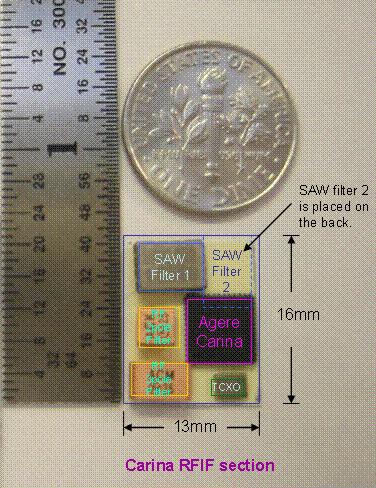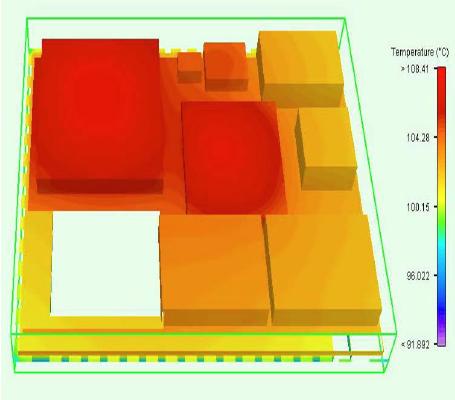

The Fourth Generation Systems Circa 2008

The Fourth generation chipset could be assembled in a very small module
The fourth generation was a great technical success. Unfortunately the customer plans to use the internal solution and to shift to an internal design was a formidable force. We ceased investing in business. There would not be a fifth generation of chips; but the chipset's are being manufactured and supplied to the industry still in 2010. The sad end to the story is a lesson in business models.

Thermal simulation of a complete receiver module; the radio features packaged chips and the base band used bumped die or CSP packages to minimize height and space. The total module size would be of the order of 18 mm by 24mm. Such a module generally carries a slight cost penalty of ten to twenty percent because of the cumulative assembly yield and the difficulty in repairing the assembly relative to a PCB assembly technique. However, the costs can be recovered in total cost of ownership of a complete assembly and a complete product line.In moderate volume, this can be a very effective approach. For example, industrial radios (M2M) in wireless data often use such modules. Adoption of such a solution is often difficult as it requires a mind set change from a component purchase mind set to a complete assembly optimization approach. Moreover, the quality is more consistent than traditional PCB assembly as the production requires a more precise level or automation than standard PCB, nearing IC packaging techniques in materials science knowledge, quality and reliability knowledge, and assembly and the company's total quality systems. A lot of data exists on this total approach, but it is a difficult leap of faith for traditional companies inexperienced in assembly techniques.
Thermal simulations are very critical to long term reliability as the junction temperature of the chips cannot be exceed. These are a critical part of module design.
Unlike the highly integrated module on the left a traditional PCB module uses standard techniques. The module above uses the fourth generation chipset, I believe it is found in production of cars today, but cannot disclose the customer. The implementation is very clean, and compared to the second generation chipset, it uses only one circuit board instead of two; it has approximately one third the footprint, and the board is populated with components on a single side. This was a great success and the automotive industry suppliers liked the solution a lot.
As soon as chips were sampled, the information was published in the press:
Opinion: About Silicon Germanium RF Chips:
I like SiGe technology for low power, high dynamic range devices. However, a mix of CMOS and SiGe is a good tradeoff for power consumption and front end performance. The dynamic range requirements of some systems is so challenging that special measures are needed, and the technology invented by IBM fellow Bernie Meyerson did the trick for this application. TSMC has a process in place for mass production, making this more producible than a boutique process.
Special Test Methods
The purchase of this equipment was an accelerator to the team performance. Instead of testing the prototypes and verifying parameters in the field, we were able capture difficult events, and rerun these events in the lab. Effectively, we recorded the radio signal environment much the same way as you would record a piano performance. The van which held the equipment was equipped with inverters and batteries which could run a suite of test equipment, including spectrum analyzers, and receiver performance monitors. We would capture a number of receiver health metrics and line them up against the measurements of the received signal and the surrounding interference environment. This would give us the data we needed to make good decisions.The FPGAs in the test rack prototypes became an untenable approach and when the project was restarted in late 2005, we decided to redesign all the FPGAs. This would allow many advantages: